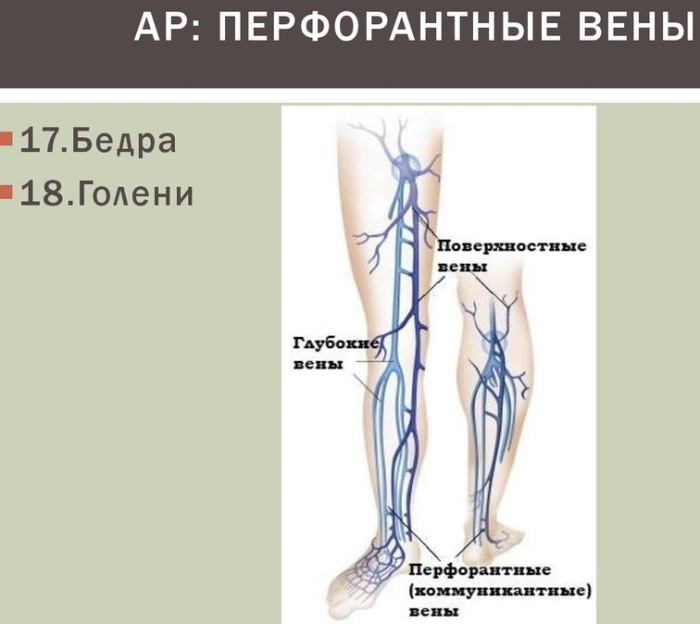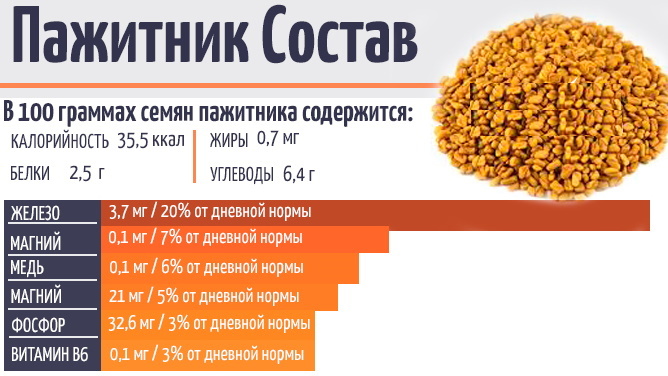Content
- Causes of the disease
- Symptoms
- Classification and stages of development of humeral-scapular periarthritis
- Complications and prognosis
- Diagnostics
- Medical treatment of humeral-scapular periarthritis
- Physiotherapy at home
- Operative treatment
- Physiotherapy
- Video about humeroscapular periarthritis
Shoulder-scapular periarthritis is considered a fairly common disease among patients of different ages. In this case, the symptoms of pathology may appear not only in the elderly. The disease is accompanied by manifestations of varying intensity, proceeds in an acute or subacute form. Medication and physiotherapy can be carried out at home if the patient has no complications.
Causes of the disease
Periarthritis of the shoulder is a disease of inflammatory origin, affecting the soft tissues located near the shoulder joint and the tissues of the articular joint itself. Degenerative pathology is accompanied by severe symptoms that worsen the general condition and lead to the development of complications.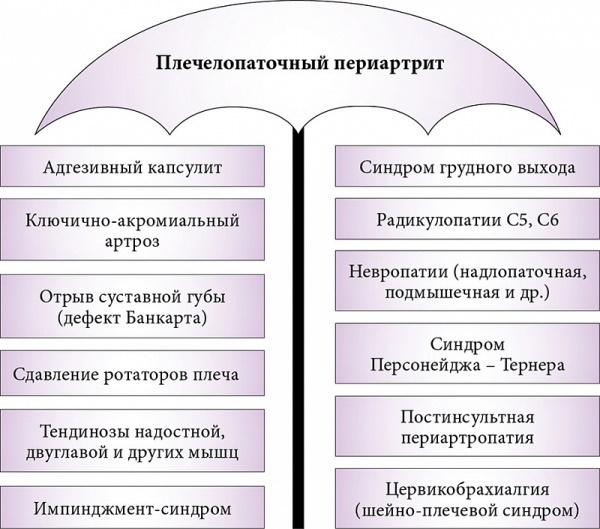
The main causes of the pathological condition:
- Hereditary predisposition to pathologies of the articular joints and the entire musculoskeletal system. In patients with such a predisposition, symptoms occur several times more often than in patients who do not have relatives with similar disorders.
- Violation of metabolic processes in the cartilage tissue, in which its thinning and the appearance of symptoms of inflammation are observed.
- Injuries to the shoulder joint, muscle sprains, ligaments, tendon damage. In this case, the inflammation is accompanied by severe pain and limited mobility.
- Increased physical activity, in which the articular joint has a constant load.
- A sedentary lifestyle, as well as a long stay in one position, can provoke an inflammatory process.
- Hypothermia of the body, in which immunity is weakened.
- Somatic pathologies, which are accompanied by damage to the synovial bag, cartilage tissue, ligaments.
- Inflammatory diseases of muscles, tendons. Such diseases can provoke the spread of the inflammatory process to the joint capsule.
- Degenerative-dystrophic diseases of the spinal column, in which blood circulation in the joint area is impaired.
- The presence of chronic diseases of the musculoskeletal system. At the same time, earlier in patients there may be no symptoms of damage to the shoulder joint.
- Excess weight can be a provoking factor, as it increases the load on the articular joint during any physical exercise.
- Tuberculous damage to the tissues of the articular joint. The disease can provoke an aggravation of the inflammatory process in the articular joint.
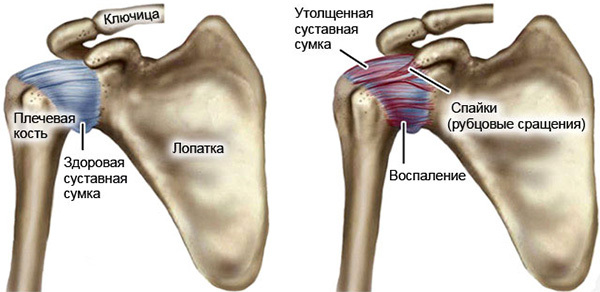
Shoulder-scapular periarthritis. Treatment
These and some other reasons provoke inflammation. The disease does not always develop against the background of one provoking factor, often several deviations lead to the appearance of symptoms of periarthritis.
Symptoms
Shoulder-scapular periarthritis (drug treatment does not always bring results within a short period of time) is accompanied by various manifestations that affect not only the musculoskeletal apparatus.
The most common symptoms of the disease are:
- Pain in the area of the affected joint is considered the most common symptom. Discomfort appears when you move your hand to the side, as well as lifting weights, doing physical exercises.

- Swelling of tissues in the area of the shoulder joint. Often, the symptom is accompanied by redness of the skin, and the swelling leads to aggravation of the pain.
- Difficulty performing common household manipulations. The patient cannot dress himself or carry out hygiene procedures, which reduces the quality of life.
- An increase in body temperature, pain in muscles and articular joints appears often, which only worsens the patient's well-being.
- Weakness and fatigue, decreased performance.
- Weakening of the muscles of the affected limb, associated with a decrease in the load on them due to severe discomfort.
- Decreased appetite, which is associated with local and systemic reactions in the acute period of the disease.
- In the area of inflammation, an increase in temperature is also observed, which is noted during examination and palpation of the articular joint, soft tissues.
- Disorder of the digestive system occurs in patients who additionally have a history of disorders of the digestive system.
The deterioration of the general condition is associated with local symptoms of the shoulder joint. They can manifest themselves in different forms, depending on the severity of symptoms from the articular joint.
Classification and stages of development of humeral-scapular periarthritis
Shoulder-scapular periarthritis can occur in different forms, therefore, experts distinguish several types of pathology. Medication and physiotherapy treatment is also selected depending on the type of disease.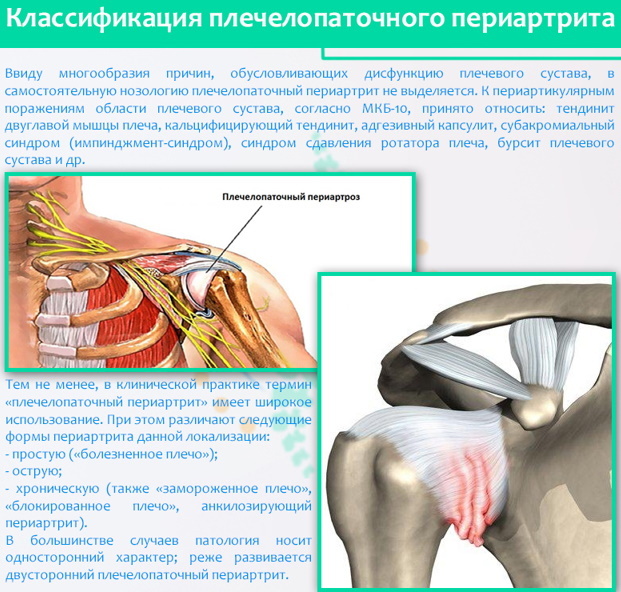
| Type of disease | Peculiarities |
| Simple | The most common form of a pathological condition in which there are no acute symptoms, but the patient's general condition worsens. Pain and limitation of movement is accompanied by swelling and a slight increase in body temperature. Complications with this form of periarthritis rarely develop, and the symptoms are eliminated rather quickly when the correct treatment is prescribed. |
| Spicy | The acute form most often occurs in the absence of treatment after the first signs of the disease appear. It is accompanied by severe pain, an increase in body temperature, and a deterioration in general condition. When prescribing treatment, the symptoms are not eliminated so quickly, progression is possible pathological process and the development of complications from healthy tissues, other parts musculoskeletal system. |
| Chronic | In chronic periarthritis, the symptomatology manifests itself in a subacute form, but periodically the condition worsens. Complications with this type of disease develop in the absence of treatment, as well as with a prolonged course of the inflammatory process. |
Depending on the presence of concomitant deviations, the disease can be complicated and uncomplicated. In the first case, the patient's condition is serious, timely and correct treatment is required. The uncomplicated course of the disease is treated quickly, the patient's condition does not deteriorate as a result of the appearance of abnormalities from other organs or tissues.
The pathological condition proceeds in several stages, which are determined during the examination. The initial stage is accompanied by pain and associated mild systemic disorders. At this stage, the patient usually does not consult a doctor, since there are no severe manifestations of the disease.
The progressive stage is accompanied by severe pain and severe general disorders that affect not only the musculoskeletal system. At this stage, the patient usually visits a doctor who determines the severity of the manifestations and the presence of complications.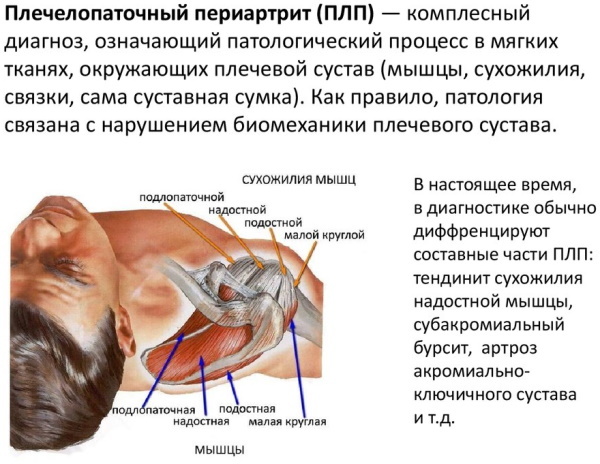
The advanced stage is considered the most difficult and dangerous for the patient, since it is accompanied by acute symptoms and complications. Treatment at this stage is aimed not only at eliminating the symptoms of the articular joint, but also at preventing the further development of complications. Depending on the stage of the disease, the therapy regimen is determined.
Complications and prognosis
Shoulder-scapular periarthritis (drug treatment involves the use of funds from different groups) can provoke complications in the absence of therapy and the rapid progression of the pathological condition. Usually, the prognosis for the patient is favorable, especially with the timely administration of medications.
But sometimes complications can develop:
- The transition of pathology to a chronic form.
- The spread of the inflammatory process to closely spaced tissues.
- Impaired mobility in the articular joint.
- Attachment of a bacterial infection affecting the joint capsule.
- Involvement of nerve endings in the pathological process.
- Complete destruction of the cartilage tissue of the articular junction, in which movement in the articular junction becomes impossible.
- Rupture of the ligaments of the shoulder joint with minimal stress.
In the presence of concomitant deviations, the prognosis for the patient may not be favorable. In this case, the treatment is complicated, the patient must be admitted to a hospital.
Diagnostics
When symptoms of a disease appear, a visit to a doctor is required, who will determine the need for a particular diagnostic method.
To determine the stage of the disease, the presence of complications, a comprehensive examination is carried out:
- Examination and palpation of the affected area - the first and most important stage of diagnosis. The specialist not only examines the affected area, but also interrogates the patient, finds out the time of the onset of complaints and the presence of accompanying deviations. Based on these data, a further survey scheme is determined.
- Clinical blood test - an obligatory stage of diagnostics, which involves the determination of basic blood parameters by examining the material in the laboratory. If necessary, a detailed clinical blood test is prescribed, which helps to determine the presence of even an insignificant focus of inflammation in other organs and tissues.
- Biochemical blood test it is not always necessary, but sometimes it helps to determine the presence of connective tissue diseases. The most important point in the diagnosis is the level of rheumatic test.
-
X-ray diagnostics not always shown. Usually, in the absence of complications, the informative value of this method is low, but it can be carried out in order to determine the presence of degenerative-dystrophic changes.

- Ultrasound procedure the joint joint is also not considered the main and most important research method, but it is prescribed to exclude the presence of severe complications in the joint capsule. In the study, the doctor assesses the condition of not only the bursa, but also the soft tissues in the affected area.
After receiving the diagnostic results, the doctor prescribes the most effective medicines in each case. Additional research methods may be prescribed on an individual basis.
Medical treatment of humeral-scapular periarthritis
Shoulder-scapular periarthritis (drug treatment always involves a combination of drugs in different forms) is treated with tablets, solutions, ointments and gels. Depending on the course of the pathological process, drugs may differ, as well as the duration of their use, dosage.
In most cases, patients are prescribed the following medications:
- Naklofen helps relieve acute pain and has anti-inflammatory properties. When applied, the inflammation is quickly relieved, the general condition of the patient is alleviated. The solution is injected intramuscularly at 3 ml per day. It is allowed to divide the daily dose by 2 times. The duration of treatment does not exceed 5 days.
- Nise gel possesses analgesic and anti-inflammatory properties, therefore it is used in the acute stage of the disease to alleviate the condition. Apply a thin layer of the product to the affected area, it is allowed to rub it in with light movements. The procedure is repeated 2 times a day, and the duration of treatment is 7-10 days.
- Diclofenac helps to relieve the patient of pain with intramuscular injection of 3 ml of solution per day. The tool in this form is used no longer than 5 days in a row, it additionally has anti-inflammatory properties. An agent is also produced in the form of a gel for external use, which is applied to the affected area 2 times a day with a thin layer. Gel treatment lasts no more than 7 days.
- Ketorol indicated for severe pain, when other remedies do not help to eliminate the symptom. The patient at home can take 1-2 tablets per day, and the duration of therapy is 5-7 days. If the patient is in the hospital, he is injected with a solution of 1 ml intramuscularly no more than 2 times a day.
-
Mucosat possesses not only anti-inflammatory, but also chondroprotective properties. The remedy helps to eliminate pain and inflammation, stimulates the restoration of cartilage tissue, if it is involved in the inflammatory process. For 1 procedure, you need to take 1 ampoule of the drug, the solution is injected intramuscularly. The duration of the patient's treatment is 10-25 days, depending on the severity of the symptoms.

Mucosat injections - Meloxicam also has pronounced anti-inflammatory and analgesic properties. The drug can be taken in tablet form, 1-2 tablets per day for 5-7 days. If it is impossible to prescribe tablets, a solution is used, which is administered intramuscularly, 1.5 ml per day.
- Voltaren Emulgel is highly effective, relieves inflammation and quickly relieves pain. The gel is applied in a thin layer no more than 3 times a day, the therapeutic course lasts 10 days.
- Dexamethasone injected intramuscularly at 1-2 ml per day, depending on the severity of manifestations. The use of the remedy is necessary in severe cases, when the inflammatory process progresses rapidly, and conventional remedies do not help to improve the condition. The drug quickly eliminates pain and swelling of tissues, which has a positive effect on the course of the disease.
- Diprospan refers to glucocorticosteroid drugs, therefore, quickly eliminates signs of inflammation in the acute course of a pathological condition. When the solution is injected in the amount of 1 ampoule intramuscularly, edema, redness are eliminated and the spread of the inflammatory process to healthy tissues is prevented. The tool is injected no more than 2-3 times, due to its pronounced properties.
The dosage and duration of use can vary individually for each patient.
Physiotherapy at home
Physiotherapy is considered an effective way to improve the patient's condition. But hardware methods are not recommended for use in the acute stage, they cannot be used at home. Independently, the patient can do compresses, rubbing and take medicinal baths.
Cabbage leaf compress is considered the most common remedy for pain, swelling, and associated inflammatory symptoms. The compress should be applied at night. To do this, it is necessary to slightly beat off the cabbage leaf until the juice appears, apply to the affected area. The sheet should be fixed with a bandage. Repeat the procedure for 7-10 days in a row to obtain a therapeutic result.
Tincture of calendula can be used for grinding. It can be prepared from 100 ml of alcohol or vodka, 50 g of dried calendula flowers. The agent should be infused for 2 weeks, then filtered and used to rub the affected articular joint 2 times a day. The duration of treatment is 10 days, but if necessary, it is allowed to use the home composition for a long time.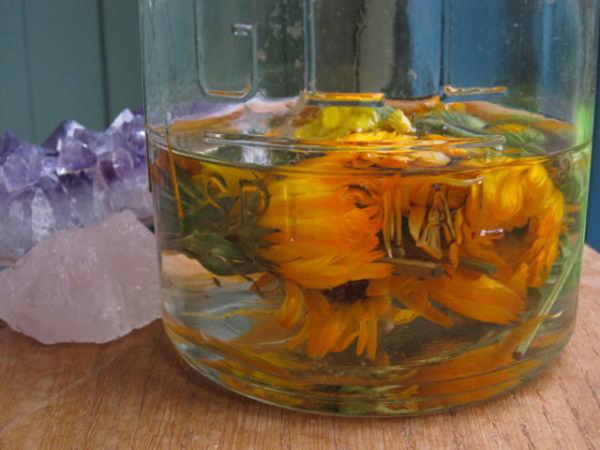
Warm hay baths are one of the most effective home remedies. At elevated body temperature, procedures are not performed. For 1 session, you will need 500 g of dried hay, 10 liters of water. It is necessary to cook the composition for 10-20 minutes, leave to cool, filter.
Add the resulting broth to a bath of warm water. It is necessary to take a bath for 20 minutes. It is allowed to repeat the manipulation 2-3 times a week. The course of therapy consists of 10 sessions. In the presence of vascular pathologies, the method is not applied.
Experts draw the removal of patients to the fact that in the presence of concomitant complications, pathologies other parts of the musculoskeletal system, do not carry out any procedures at home recommended. Any method has contraindications and can provoke negative reactions.
Operative treatment
Shoulder-scapular periarthritis (drug treatment can be combined with the use of home formulations) is usually treated conservatively, but sometimes surgery is necessary.
The operation is carried out with the development of severe purulent inflammation, the rapid progression of pathology, the spread of the disease to healthy tissues, and a critical deterioration in the general condition.
The intervention is carried out under local or general anesthesia, the recovery period lasts up to 3 weeks. During rehabilitation, the patient takes antibacterial and some other drugs.
Physiotherapy
In the acute period, physiotherapy exercises are not indicated for the patient, since it can aggravate the course of the pathological condition. But after stopping the inflammatory process during the rehabilitation period, it is allowed to perform exercises to restore muscle tone and improve mobility in the articular joint.
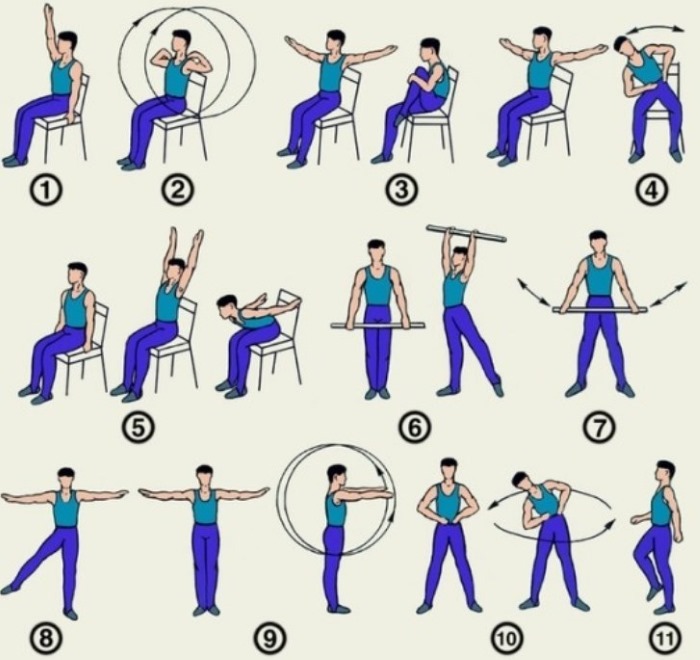
Specific exercises are selected individually for the patient.
The following exercises are most often recommended:
- Leaving a straight arm to the side.
- Hand rotation clockwise and counterclockwise.
- Swing your hands.
- Rotation of the arm bent at the elbow joint.
In addition, it is recommended to perform exercises for other muscle groups, since training only the affected limb does not help to get a good result. The training program is drawn up by a specialist, determines the duration and frequency of training. Patients are not advised to do exercises on their own without a doctor's approval. This increases the likelihood of complications.
Each exercise is performed 5 to 15 times. At the same time, the patient should not experience discomfort or pain during the lesson. Excessive fatigue and weakness is considered a reason to stop exercising.
Shoulder-scapular periarthritis is considered a common disease of the musculoskeletal system, occurs in patients of different ages and can provoke complications in the absence of therapy. Medical and physiotherapeutic treatment of pathology should be prescribed by a doctor. Self-medication provokes an aggravation of symptoms and the development of consequences that require surgical intervention.
Video about humeroscapular periarthritis
Symptoms of the humeral-scapular periarthritis:

